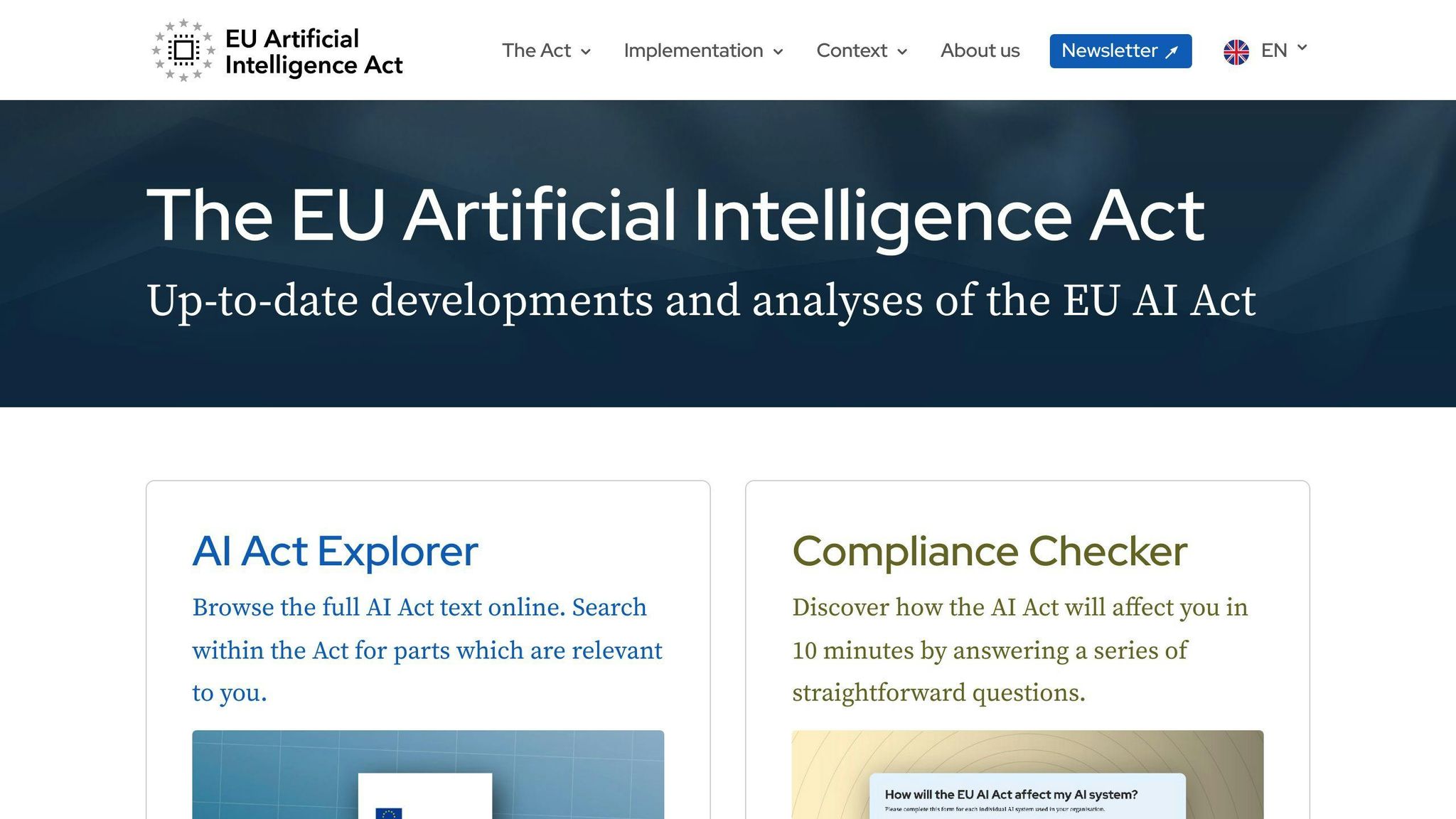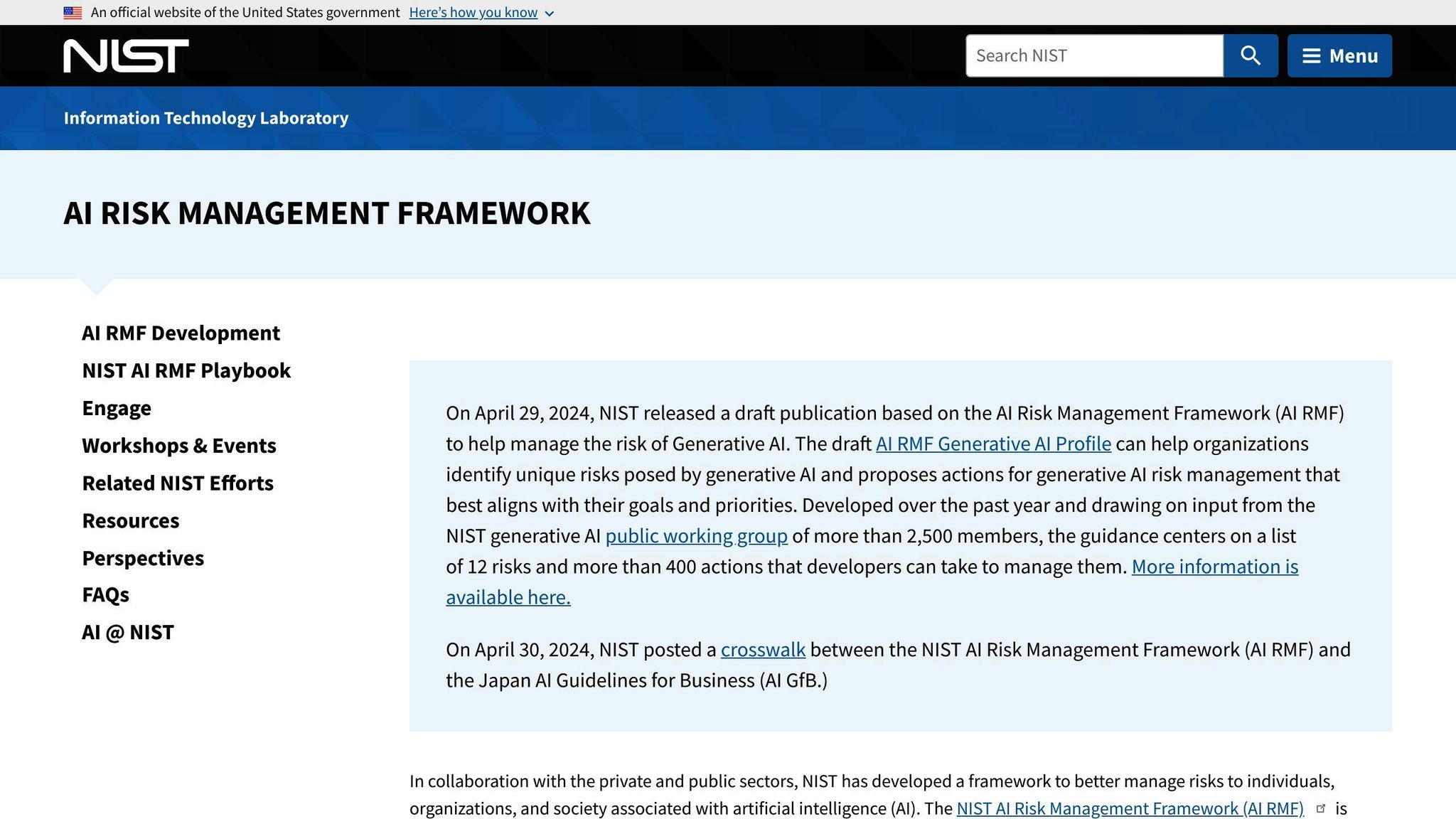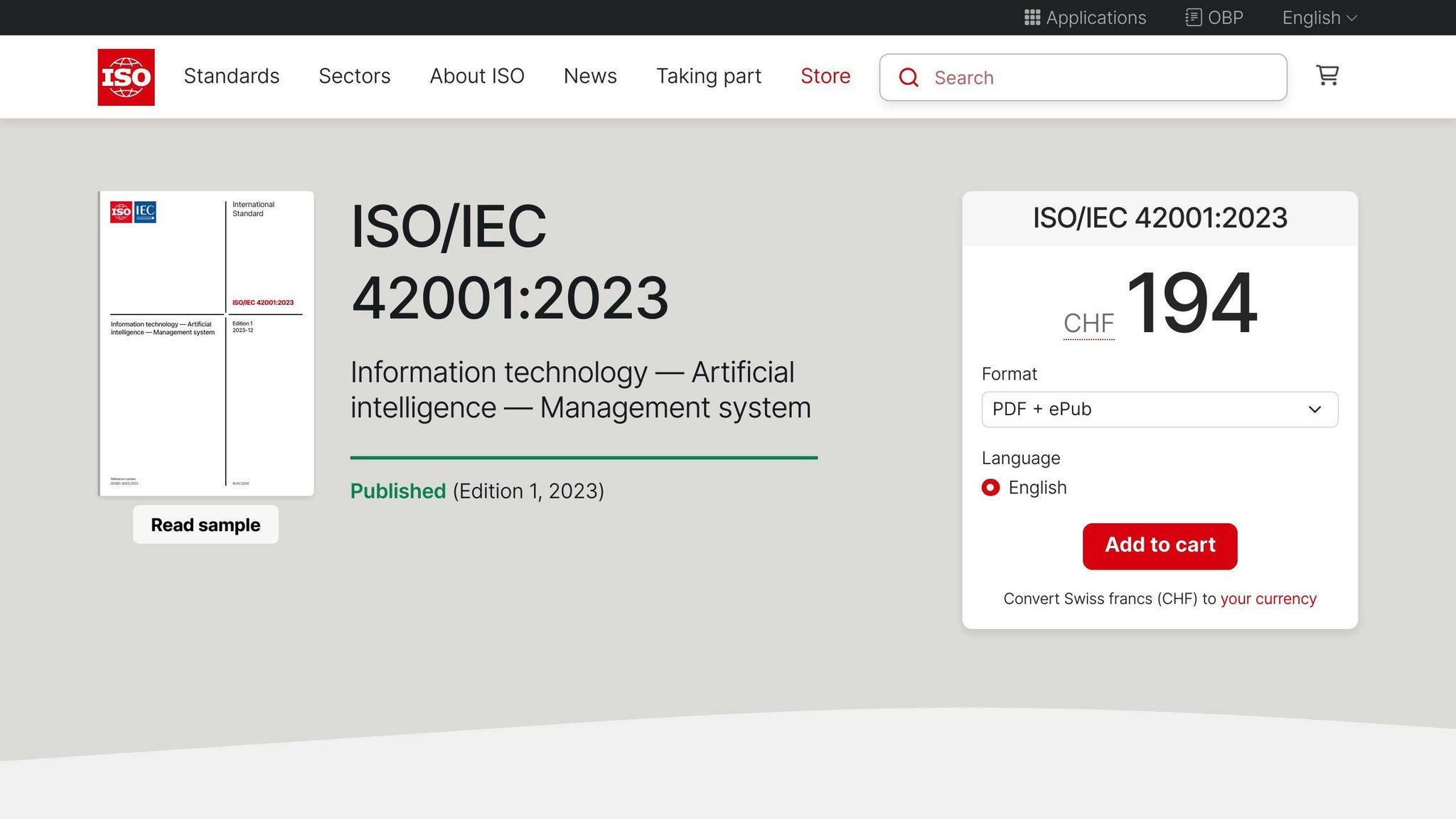
Navigating Global AI Regulations: 2024 Business Guide
Stay compliant across regions without legal headaches. Map your AI risks, understand key frameworks, and build monitoring systems that work.

Written by
Adam Stewart
Key Points
- Map your AI systems by risk level and jurisdiction requirements
- Start with EU GDPR and NIST frameworks for foundation compliance
- Build cross-border strategies before expanding internationally
- Monitor regulatory changes monthly to avoid costly surprises
Complying with AI regulations is crucial for businesses in 2024. With varying rules across regions, companies must navigate a complex legal landscape to ensure responsible AI development and use. Failure to comply can result in severe consequences:
- Legal penalties and fines
- Financial losses
- Damage to brand reputation and consumer trust
To mitigate risks and ensure compliance, businesses should:
-
Understand Key AI Regulations
- Data Privacy Laws (e.g., GDPR)
- Ethical AI Guidelines (e.g., EU Ethics Guidelines)
- AI Governance Frameworks (e.g., NIST AI Risk Management Framework)
-
Assess AI Compliance Needs
- Identify AI applications within the organization
- Determine relevant rules based on industry, location, and use cases
- Conduct risk assessments to prioritize compliance efforts
-
Implement Compliance Measures
- Establish AI oversight and governance structures
- Ensure proper data practices for AI systems
- Implement risk management processes
-
Comply with Specific AI Rules
- EU AI Act: Ensure safety, transparency, and respect for fundamental rights
- Brazil's AI Bill: Prevent bias, ensure transparency, and protect human rights
- China's AI Governance Rules: Obtain necessary permits, ensure data localization, and prioritize national security
- NIST AI Risk Management Framework: Identify, assess, and mitigate AI risks
- ISO/IEC 42001: Establish an AI management system
-
Manage Cross-Border Compliance
- Harmonize global compliance efforts
- Develop strategies to address conflicting regulations
-
Stay Up-to-Date with Changing Rules
- Regularly review and update compliance measures
- Monitor regulatory changes and engage with industry groups
- Conduct periodic audits to assess compliance effectiveness
By prioritizing AI compliance, businesses can avoid legal issues, prevent financial penalties, maintain reputation, gain a competitive advantage, drive innovation, and minimize risks.
Related video from YouTube
Understanding AI Rules
Defining Key Terms
AI regulations involve laws, guidelines, and standards that govern the development and use of artificial intelligence (AI) systems. Here are some key terms:
- Artificial Intelligence (AI): Computer systems that can perform tasks requiring human-like intelligence, such as learning, problem-solving, and decision-making.
- Data Privacy: Protecting personal information and giving individuals control over their data.
- Ethical AI: Developing and using AI systems that are fair, transparent, and unbiased, prioritizing human well-being.
- AI Governance: Frameworks, policies, and procedures that guide the responsible development and use of AI systems.
Types of AI Regulations
AI regulations can be categorized into several types:
| Type | Description |
|---|---|
| Data Privacy Laws | Regulations that protect personal data and ensure individuals have control over their information, such as the EU's General Data Protection Regulation (GDPR). |
| Ethical AI Guidelines | Frameworks that promote the development and use of fair, transparent, and unbiased AI systems, such as the European Commission's Ethics Guidelines for Trustworthy AI. |
| AI Governance Frameworks | Regulations that provide guidelines for the responsible development, deployment, and use of AI systems, ensuring accountability and transparency, such as the NIST AI Risk Management Framework. |
Major AI Regulatory Frameworks
Several countries and regions have established major AI regulatory frameworks:
| Framework | Description |
|---|---|
| EU AI Act | A comprehensive framework that aims to ensure AI systems are safe, transparent, and accountable. |
| Brazil's AI Bill | A proposed law that aims to regulate the development and use of AI systems in Brazil, ensuring transparency, accountability, and data protection. |
| China's AI Governance Regulations | Regulations that aim to promote the development and use of AI systems in China, while ensuring national security, public safety, and social stability. |
| NIST AI Risk Management Framework | A voluntary framework that provides guidelines for managing risks associated with AI systems, ensuring accountability and transparency. |
These regulatory frameworks are shaping the development and use of AI systems globally, and businesses must understand and comply with them to ensure responsible AI adoption.
Assessing Your AI Compliance Needs
Evaluating your AI compliance requirements is crucial when navigating global AI regulations. This process involves identifying AI applications within your organization, determining relevant rules based on your industry, location, and AI use cases, and conducting a risk assessment to prioritize compliance efforts.
Identifying AI Applications
To identify AI applications within your organization, review your business operations and pinpoint areas where AI is currently used or planned for future use. This includes AI-powered tools, software, and systems utilized across various departments like customer service, marketing, and product development. Consider these questions:
- What AI technologies are currently employed in our organization?
- What AI applications are planned for future implementation?
- What are the specific use cases for each AI application?
Determining Relevant Rules
Once you've identified the AI applications within your organization, determine which AI regulations apply based on your industry, location, and specific AI use cases. Research the rules that govern your organization, considering the following factors:
| Factor | Description |
|---|---|
| Industry-specific regulations | Are there rules governing AI use in your industry, such as healthcare or finance? |
| Location-based regulations | Are there regulations governing AI use in specific regions or countries where your organization operates? |
| AI use case-specific regulations | Are there rules governing specific AI use cases, such as facial recognition or autonomous vehicles? |
Conducting Risk Assessments
Conducting a risk assessment is crucial for prioritizing AI compliance efforts. This involves identifying potential risks associated with AI applications and determining the likelihood and impact of each risk. Follow these steps:
1. Identify potential risks
What are the potential risks associated with each AI application, such as bias, privacy, or security risks?
2. Assess risk likelihood and impact
What is the likelihood and potential impact of each identified risk?
3. Prioritize risks
Which risks should be prioritized based on their likelihood and potential impact?
Making Your AI Compliant
To ensure your AI systems follow global rules, you need a solid compliance plan. This plan should outline how you'll manage AI development and use, including:
AI Oversight
Set up a clear structure for overseeing AI compliance:
- Designate roles like an AI compliance officer or committee
- Involve experts from tech, law, ethics, and business fields
- Create policies for developing, deploying, and maintaining AI
Data Practices
Properly handle data used in AI systems:
- Establish data policies for sourcing, storage, and processing
- Validate data quality and clean data as needed
- Protect data privacy and security through encryption and access controls
Risk Management
Regularly assess and monitor AI risks:
| Activity | Purpose |
|---|---|
| Risk Assessments | Identify potential AI risks like bias, privacy, or security issues |
| Testing | Ensure AI systems function as intended |
| Monitoring | Detect and respond to AI-related incidents |
sbb-itb-ef0082b
Complying with Specific AI Rules
Adhering to AI regulations requires understanding the specific rules and guidelines governing AI development and deployment. This section provides an overview of major AI regulations, their key requirements, and best practices for compliance.
EU AI Act

The EU AI Act aims to ensure AI systems are safe, transparent, and respect fundamental rights. To comply, businesses must:
- Conduct risk assessments to identify high-risk AI applications
- Implement transparency measures, such as explainability and information on data used
- Establish user awareness and consent mechanisms
- Ensure data privacy and security
- Implement human oversight and accountability mechanisms
Best practices include:
- Establishing an AI governance structure
- Developing a risk management framework
- Implementing data management practices that ensure data quality and privacy
- Providing training on AI ethics and responsible development
Brazil's AI Bill
Brazil's AI Bill promotes the development and use of AI while ensuring respect for human rights and dignity. To comply, businesses must:
- Ensure AI systems are transparent, explainable, and auditable
- Implement measures to prevent bias and discrimination
- Establish data protection mechanisms
- Ensure accountability and liability for AI-related damages
Best practices include:
- Implementing diversity and inclusion measures in AI development
- Establishing a data protection officer
- Developing a framework for AI ethics and responsible development
China's AI Governance Rules
China's AI governance rules regulate AI development and deployment, ensuring national security, public safety, and social stability. To comply, businesses must:
- Obtain necessary permits and licenses for AI development and deployment
- Implement data localization and storage requirements
- Ensure AI systems are secure and resistant to cyber threats
- Establish accountability and liability mechanisms
Best practices include:
- Establishing an AI governance structure
- Implementing data management practices that ensure data security and localization
- Developing a framework for AI ethics and responsible development
NIST AI Risk Management Framework

The NIST AI Risk Management Framework provides guidelines for managing AI-related risks. To comply, businesses must:
- Identify and assess AI-related risks
- Implement risk mitigation and management strategies
- Establish a risk management framework
- Continuously monitor and evaluate AI-related risks
Best practices include:
- Establishing a risk management team
- Developing a risk management framework that integrates with existing practices
- Implementing continuous monitoring and evaluation mechanisms
ISO/IEC 42001 (AI Management System)

ISO/IEC 42001 provides a framework for establishing, implementing, maintaining, and improving an AI management system. To comply, businesses must:
- Establish an AI management system
- Implement AI governance and risk management practices
- Ensure AI systems are transparent, explainable, and auditable
- Establish accountability and liability mechanisms
Best practices include:
- Establishing an AI governance structure
- Implementing data management practices that ensure data quality and privacy
- Developing a framework for AI ethics and responsible development
Cross-Border AI Compliance
Complying with AI rules across different countries poses unique challenges for global businesses. With varying regulations in each region, companies must navigate complex legal landscapes to ensure compliance. This section provides strategies for harmonizing AI compliance efforts globally and managing conflicting rules.
Challenges of Cross-Border Compliance
Adhering to AI regulations across multiple jurisdictions can be difficult. Businesses face issues such as:
- Different regulatory requirements and standards
- Conflicting laws and rules
- Language and cultural barriers
- Limited resources and expertise
To overcome these challenges, businesses must thoroughly understand AI regulations in each country they operate in.
Harmonizing Compliance Efforts
To harmonize global AI compliance efforts, businesses can:
- Establish a centralized AI governance structure
- Develop a global AI compliance framework
- Implement standardized AI development and deployment practices
- Provide training on AI ethics and responsible development
- Engage with regulatory bodies and industry associations to stay informed about changing regulations
By taking a proactive and harmonized approach to AI compliance, businesses can reduce the risk of non-compliance and ensure a consistent approach to AI development and deployment.
Managing Conflicting Rules
When faced with conflicting AI regulations, businesses must:
| Action | Purpose |
|---|---|
| Conduct thorough risk assessments | Identify potential conflicts |
| Develop mitigation strategies | Implement additional safeguards or obtain exemptions |
| Engage with regulatory bodies | Clarify conflicting regulations |
| Consider seeking legal counsel | Navigate complex regulatory issues |
Keeping Up with Changing Rules
Staying compliant with AI regulations requires ongoing effort. Rules change over time, so businesses must regularly review and update their practices.
Reviewing Compliance Measures
Businesses should:
- Conduct regular risk assessments to find potential compliance gaps
- Update AI development and use practices to match new rules
- Provide ongoing training on AI ethics and responsible use
- Stay informed about changing regulations through industry groups
Regularly reviewing compliance helps reduce the risk of violations.
Monitoring Regulatory Changes
To stay ahead of new risks and rules, businesses can:
| Action | Purpose |
|---|---|
| Track regulatory updates | Stay informed about changes in key regions |
| Engage with industry groups | Learn about emerging rules and best practices |
| Use AI tools | Automatically monitor rule changes and flag potential issues |
| Centralize AI governance | Oversee development and use practices across the organization |
Proactively monitoring regulatory changes allows businesses to address new requirements before falling out of compliance.
Periodic Audits
Regular audits are essential for ensuring compliance:
- Audit AI practices to identify potential gaps
- Assess the effectiveness of compliance measures
- Use AI tools to automate audits and reduce errors
- Engage external auditors for independent reviews
Audits provide an objective evaluation of a business's compliance efforts and highlight areas for improvement.
Conclusion
Following global AI rules is crucial for businesses. As AI keeps changing how companies work, obeying new regulations is essential. By prioritizing compliance, organizations can avoid legal issues, financial penalties, and damage to their reputation.
Effective AI compliance is not just a requirement but a strategic advantage. It helps build customer trust, gain a competitive edge, and drive innovation while minimizing risks. With a solid AI compliance plan, businesses can ensure their AI systems are fair, transparent, and accountable.
Non-compliance consequences can be severe, including legal penalties, fines, reputational harm, and loss of customer trust. Therefore, businesses must stay ahead of regulatory changes, continuously monitor updates, and adjust their practices accordingly.
| Benefit of AI Compliance | Description |
|---|---|
| Avoid Legal Issues | Comply with laws and regulations to prevent legal action. |
| Prevent Financial Penalties | Avoid costly fines and penalties for non-compliance. |
| Maintain Reputation | Build trust with customers and stakeholders. |
| Gain Competitive Advantage | Demonstrate responsible AI practices to stand out. |
| Drive Innovation | Develop AI systems with fairness and accountability in mind. |
| Minimize Risks | Proactively address potential issues and mitigate risks. |
Key Takeaways
1. Stay Informed
- Monitor regulatory updates in regions where your business operates.
- Engage with industry groups to learn about emerging rules and best practices.
- Use AI tools to automatically track rule changes and flag potential issues.
2. Implement Compliance Measures
- Establish an AI governance structure to oversee development and use practices.
- Conduct regular risk assessments to identify potential compliance gaps.
- Update AI practices to align with new rules and regulations.
3. Prioritize Audits and Reviews
- Perform periodic audits to assess the effectiveness of compliance measures.
- Engage external auditors for independent reviews and objective evaluations.
- Use AI tools to automate audits and reduce errors.
Resources and Further Reading
To stay up-to-date on AI rules and compliance, follow these authoritative sources:
Industry Groups and Forums
- The AI Alliance: A global community working to promote responsible AI development.
- IEEE Global Initiative on Ethics of AI Systems: A forum discussing ethical AI implications and developing standards.
- AI Now Institute: A research center focused on AI's social impact and responsible development policies.
Regulatory Bodies and Government Agencies
- European Union's Artificial Intelligence Act: A regulatory framework for AI development and use in the EU.
- NIST AI Risk Management Framework: Guidelines for managing AI risks and promoting trustworthy AI.
- FTC AI Guidance: Guidance on AI development and use in the United States.
Research Institutions and Think Tanks
| Institution | Focus |
|---|---|
| Stanford Institute for Human-Centered AI (HAI) | Developing AI that benefits humanity |
| Brookings Institution's AI and Emerging Technology Initiative | Policy implications of AI and emerging technologies |
| Harvard Kennedy School's AI and Technology Initiative | Social implications of AI and responsible development policies |
Follow these resources and engage with industry associations, regulatory bodies, research institutions, and think tanks to stay informed about the latest AI regulations and compliance developments.
Summarize with AI
Related Posts
Cross-Border AI Data Transfers: Navigating Challenges
Explore the complexities of cross-border AI data transfers, ensuring secure, compliant exchange amidst evolving global data protection laws and cybersecurity threats.
China Unveils Rules for Generative AI Services
China unveils regulations for generative AI services to promote responsible development, protect user rights, and ensure national security. Learn about key requirements, scope, obligations, and impact.
AI Consent Management Best Practices: Your Complete 2025 Guide
Learn the 10 best AI consent management practices for 2024 to handle user data responsibly, build trust, and stay compliant with evolving AI technology.
10 Steps to AI Compliance: Training & Governance Tips
Discover 10 essential steps to ensure AI compliance, including understanding regulatory requirements, forming a compliance team, and implementing data governance practices.
